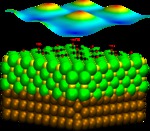 | | Interfaces between inorganic materials and organic molecules are highly interesting the viewpoint of fundamental science, interesting since the flexibility of organic chemistry allows systematically tuning the strength of the interaction between the two components. While for unreactive, semiconducting substrates, the charge in the organic material is found to be strongly localized, for weakly reactive, metallic substrates, the charge is found to be completely delocalized. At present unclear, however, is how, e.g., degenerately doped semiconductors, which show quasi-metallic conductivity, fit into this classification.
In this project, we will study by means of first principle calculations (density functional theory and beyond) (a) how the localization of charge is affected for a given interface as the nature and strength of the substrate/adsorbate interaction is gradually modified, and (b) how this affects observables at the interface. To this aim, we will investigate the adsorption of small, conjugated organic molecules on semiconductors with different doping concentrations and metals which reactivity will be modified through alloying.
Peer-reviewed publicatons:
- Erker, S. & Hofmann, O. T. Fractional and Integer Charge Transfer at Semiconductor/Organic Interfaces: The Role of Hybridization and Metallicity. J. Phys. Chem. Lett. 848–854 (2019). doi: 10.1021/acs.jpclett.8b03857.
This document is the unedited Author's version of a Submitted Work that was subsequently accepted for publication in The Journal of Physical Chemistry Letters, copyright © American Chemical Society after peer review. To access the final edited and published work see https://pubs.acs.org/doi/10.1021/acs.jpclett.8b03857
- Gerbert, D., Hofmann, O. T. & Tegeder, P. Formation of Occupied and Unoccupied Hybrid Bands at Interfaces between Metals and Organic Donors/Acceptors. J. Phys. Chem. C 122, 27554–27560 (2018).
This document is the unedited Author's version of a Submitted Work that was subsequently accepted for publication in The Journal of Physical Chemistry C, copyright © American Chemical Society after peer review. To access the final edited and published work see https://pubs.acs.org/doi/abs/10.1021/acs.jpcc.8b09606
- Harivyasi, S. S., Hofmann, O. T., Ilyas, N., Monti, O. L. A. & Zojer, E. van der Waals Interaction Activated Strong Electronic Coupling at the Interface between Chloro Boron-Subphthalocyanine and Cu(111). J. Phys. Chem. C 122, 14621–14630 (2018), doi: 10.1021/acs.jpcc.8b03675
- Wruss, E., Zojer, E. & Hofmann, O. T. Distinguishing between Charge-Transfer Mechanisms at Organic/Inorganic Interfaces Employing Hybrid Functionals. J. Phys. Chem. C 122, 14640–14653 (2018), doi: 10.1021/acs.jpcc.8b03699
This document is the unedited Author's version of a Submitted Work that was subsequently accepted for publication in The Journal of Physical Chemistry C, copyright © American Chemical Society after peer review. To access the final edited and published work see https://pubs.acs.org/doi/abs/10.1021/acs.jpcc.8b03699
- Hofmann, O. T. et al. Orientation-Dependent Work-Function Modification Using Substituted Pyrene-Based Acceptors. J. Phys. Chem. C 121, 24657–24668 (2017), doi: 10.1021/acs.jpcc.7b08451
- Erker, S., Rinke, P., Moll, N. & Hofmann, O. T. Doping dependence of the surface phase stability of polar O-terminated (0001̅) ZnO. New J. Phys. 19, 083012 (2017), doi: 10.1088/1367-2630/aa79e7
- Hofmann, O. T. & Rinke, P. Band Bending Engineering at Organic/Inorganic Interfaces Using Organic Self-Assembled Monolayers. Adv. Electron. Mater. 3, 1600373 (2017), doi: 10.1002/aelm.201600373
|